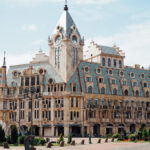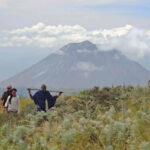Jamaica’s vibrant culture and breathtaking landscapes draw visitors worldwide. Are you curious about the origins of this thriving industry and its impact on Jamaica? SIXT.VN explores the historical roots of Jamaican tourism, highlighting its development and offering seamless travel solutions for your Vietnamese adventure. Discover the best of Vietnam with SIXT.VN’s expert travel advice, convenient airport transfers, and premium hotel booking services.
Contents
- 1. When Did Tourism Begin in Jamaica?
- 1.1 Early Tourism Infrastructure
- 1.2 Limitations of Early Tourism
- 2. How Did Tourism Prosper in Jamaica After World War I?
- 2.1 Increased Tourist Arrivals
- 2.2 Post-War Economic Factors
- 2.3 Milestone in Tourist Arrivals
- 3. What Was the Tourism Boom in the Late 20th Century?
- 3.1 Growth in Tourist Arrivals
- 3.2 Impact of Cruise Ship Arrivals
- 3.3 2019 Tourist Statistics
- 4. How Did the COVID-19 Pandemic Affect Tourism in Jamaica?
- 4.1 Initial Decline in Tourist Arrivals
- 4.2 Government Measures to Support Tourism
- 4.3 Recovery Strategies
- 5. What Are the Main Attractions That Draw Tourists to Jamaica?
- 5.1 Beaches and Coastline
- 5.2 Natural Landscapes
- 5.3 Cultural and Historical Sites
- 6. What Role Does the Jamaica Tourist Board Play in Promoting Tourism?
- 6.1 Marketing and Promotion
- 6.2 Quality Assurance
- 6.3 Research and Development
- 7. How Has Sustainable Tourism Been Integrated Into Jamaica’s Tourism Strategy?
- 7.1 Environmental Protection
- 7.2 Community Involvement
- 7.3 Cultural Preservation
- 8. What Are Some Emerging Trends in Jamaican Tourism?
- 8.1 Eco-Tourism
- 8.2 Wellness Tourism
- 8.3 Digital Marketing
- 9. What Type of Traveler Typically Visits Jamaica?
- 9.1 Demographics
- 9.2 Traveler Interests
- 10. What Challenges Do Travelers Face When Planning a Trip to Jamaica?
- 10.1 Common Difficulties
- 10.2 Solutions with SIXT.VN
- 10.3 How SIXT.VN Enhances Your Trip
- FAQ Section: Tourism in Jamaica
- 1. Who is Considered the Pioneer of Tourism in Jamaica?
- 2. What Was the Main Motivation for Early Tourists Visiting Jamaica?
- 3. How Did the Development of Transportation Impact Tourism in Jamaica?
- 4. What Role Did Cruise Ships Play in the Growth of Jamaican Tourism?
- 5. How Did the COVID-19 Pandemic Affect Jamaica’s Tourism Industry?
- 6. What Measures Has Jamaica Taken to Promote Sustainable Tourism?
- 7. What Emerging Trends Are Shaping the Future of Tourism in Jamaica?
- 8. What are the Benefits of Using SIXT.VN for Planning a Trip to Vietnam?
- 9. What Can Tourists Expect in Terms of Cultural Experiences in Jamaica?
- 10. How Does the Jamaican Government Support the Tourism Industry?
1. When Did Tourism Begin in Jamaica?
Jamaica’s tourism industry began in the late 19th century. It started with wealthy individuals seeking refuge from cold winters in England and North America. The Jamaica Tourist Board notes that the island’s climate and natural beauty made it an ideal destination for health and leisure.
1.1 Early Tourism Infrastructure
The first tourist hotels were constructed in Montego Bay and Port Antonio to accommodate these early visitors. These locations were chosen for their scenic beauty and accessibility by sea. The Myrtle Bank Hotel in Kingston, built in 1892, was another notable early establishment that catered to affluent travelers.
1.2 Limitations of Early Tourism
In those early years, Jamaican tourism was primarily exclusive to the wealthy, elderly, and a select few who could afford the journey and accommodation. This exclusivity limited the industry’s growth, but it laid the groundwork for future expansion as transportation and accessibility improved. The focus was on providing a luxurious and restful experience for those seeking respite from colder climates.
2. How Did Tourism Prosper in Jamaica After World War I?
Tourism in Jamaica experienced significant growth after World War I, driven by advancements in transportation that made international travel more accessible. Improved methods of transportation made it easier for people to travel to Jamaica from different parts of the world.
2.1 Increased Tourist Arrivals
In the early 1920s, the number of tourists visiting Jamaica annually was relatively low, likely not exceeding a few thousand. By 1938, however, this figure had risen significantly to 64,000. This increase indicates a growing interest in Jamaica as a tourist destination.
2.2 Post-War Economic Factors
The post-World War I era saw increased economic activity and leisure travel as the world recovered. Jamaica, with its natural attractions and developing infrastructure, was well-positioned to benefit from this trend. The establishment of better transportation links also played a crucial role in attracting more visitors.
2.3 Milestone in Tourist Arrivals
By 1952, the number of arrivals almost doubled to over 104,000. This milestone reflected the continued improvements in Jamaica’s tourism infrastructure and its growing popularity as a destination. The increase in tourist numbers highlighted the island’s appeal to a broader range of travelers.
3. What Was the Tourism Boom in the Late 20th Century?
The late 20th century saw a boom in Jamaican tourism, with visitor numbers continuing to climb dramatically. In 1966, the number of tourists exceeded 345,000, and by 1970, it nearly reached 415,000. This growth was fueled by increased marketing efforts and further improvements in transportation.
3.1 Growth in Tourist Arrivals
In 1982, the number of tourists exceeded 600,000, demonstrating the sustained growth of Jamaica’s tourism sector. This period saw significant investment in tourism infrastructure, including new hotels and resorts. The expansion of the industry created numerous job opportunities for locals.
3.2 Impact of Cruise Ship Arrivals
Since the 1987-88 season, the number of visitors has exceeded one million a year. This milestone was partly due to the great increase in the arrivals of cruise-ship passengers. Cruise tourism brought a new segment of travelers to Jamaica, boosting the overall numbers.
3.3 2019 Tourist Statistics
Total arrivals for 2019 were 4.23 million. This figure represents the peak of Jamaica’s tourism industry before the onset of the COVID-19 pandemic. The success of the industry in 2019 was a testament to Jamaica’s appeal as a premier tourist destination.
4. How Did the COVID-19 Pandemic Affect Tourism in Jamaica?
The COVID-19 pandemic had a devastating impact on the global travel and tourism industry, including Jamaica. Travel restrictions and health concerns led to a significant decline in tourist arrivals, affecting the island’s economy. According to the Jamaica Tourist Board, the pandemic resulted in substantial losses in revenue and employment within the tourism sector.
4.1 Initial Decline in Tourist Arrivals
With the onset of the pandemic in early 2020, Jamaica experienced a sharp decline in tourist arrivals. Lockdowns and travel bans prevented many people from traveling, resulting in empty hotels and resorts. The economic impact was immediate and severe.
4.2 Government Measures to Support Tourism
The Jamaican government implemented various measures to support the tourism industry during the pandemic. These measures included financial assistance to businesses and workers in the sector, as well as the development of health and safety protocols to ensure the safe reopening of tourist facilities. The Jamaica Tourist Board played a key role in promoting these initiatives and reassuring potential visitors.
4.3 Recovery Strategies
As the pandemic subsided, Jamaica focused on strategies to revive its tourism sector. These strategies included targeted marketing campaigns, enhanced health and safety measures, and the development of new tourism products. The goal was to attract visitors back to the island while ensuring their safety and well-being.
5. What Are the Main Attractions That Draw Tourists to Jamaica?
Jamaica is known for its warm climate, year-round sunshine, beaches, and beautiful landscape. These natural attractions are the primary draw for tourists from all over the world. The island also boasts a rich cultural heritage, including reggae music, vibrant art, and delicious cuisine.
5.1 Beaches and Coastline
Jamaica’s beaches are among its most famous attractions. From the white sands of Negril to the turquoise waters of Montego Bay, the island offers a variety of coastal experiences. These beaches provide opportunities for swimming, sunbathing, water sports, and relaxation.
5.2 Natural Landscapes
Beyond the beaches, Jamaica’s natural landscapes include lush mountains, rainforests, and waterfalls. The Blue Mountains, a UNESCO World Heritage Site, are popular for hiking and birdwatching. Dunn’s River Falls is another iconic attraction, where visitors can climb the cascading water.
5.3 Cultural and Historical Sites
Jamaica’s cultural and historical sites offer a glimpse into the island’s past and present. The Bob Marley Museum in Kingston celebrates the life and music of the reggae legend. Historic plantations, such as Rose Hall, provide insights into Jamaica’s colonial history.
6. What Role Does the Jamaica Tourist Board Play in Promoting Tourism?
The Jamaica Tourist Board (JTB) plays a crucial role in promoting tourism to the island. As the national tourism agency, the JTB is responsible for marketing Jamaica as a premier tourist destination and ensuring the quality of the tourism product. According to the Ministry of Tourism, the JTB’s efforts are essential for driving economic growth and development in Jamaica.
6.1 Marketing and Promotion
The JTB conducts extensive marketing and promotional campaigns to attract tourists from around the world. These campaigns include advertising, public relations, and participation in international trade shows. The JTB also works closely with travel agents and tour operators to promote Jamaica as a destination.
6.2 Quality Assurance
The JTB is responsible for ensuring the quality of the tourism product in Jamaica. This includes setting standards for hotels, resorts, and other tourist facilities. The JTB also provides training and certification programs for tourism workers to ensure they meet the highest standards of service.
6.3 Research and Development
The JTB conducts research to identify trends and opportunities in the tourism market. This research informs the JTB’s marketing and development strategies. The JTB also works to develop new tourism products and experiences that will appeal to a wider range of visitors.
7. How Has Sustainable Tourism Been Integrated Into Jamaica’s Tourism Strategy?
Sustainable tourism has become an important part of Jamaica’s tourism strategy. The island recognizes the need to balance economic growth with environmental protection and social responsibility. The Ministry of Tourism has implemented policies and programs to promote sustainable practices within the tourism sector.
7.1 Environmental Protection
Jamaica has implemented several initiatives to protect its natural environment, including marine parks, wildlife reserves, and reforestation programs. These initiatives aim to preserve the island’s biodiversity and natural beauty for future generations. Sustainable tourism practices also include reducing waste, conserving water, and using renewable energy sources.
7.2 Community Involvement
Community involvement is another key aspect of sustainable tourism in Jamaica. The Ministry of Tourism encourages local communities to participate in tourism development and benefit from the industry. This includes providing opportunities for local businesses to supply goods and services to tourist facilities and creating jobs for residents.
7.3 Cultural Preservation
Sustainable tourism in Jamaica also focuses on preserving the island’s cultural heritage. This includes supporting local artists, musicians, and craftspeople, as well as promoting cultural events and festivals. The goal is to ensure that tourism contributes to the preservation and celebration of Jamaica’s unique culture.
8. What Are Some Emerging Trends in Jamaican Tourism?
Several emerging trends are shaping the future of Jamaican tourism. These trends include the growth of eco-tourism, the increasing popularity of wellness tourism, and the rise of digital marketing. The Jamaica Tourist Board is adapting its strategies to capitalize on these trends.
8.1 Eco-Tourism
Eco-tourism is gaining popularity among travelers who are interested in experiencing nature and supporting conservation efforts. Jamaica offers a variety of eco-tourism experiences, including hiking, birdwatching, and exploring natural parks. These activities appeal to environmentally conscious travelers.
8.2 Wellness Tourism
Wellness tourism is another growing trend in Jamaica. Visitors are seeking opportunities to relax, rejuvenate, and improve their health. Jamaica offers a range of wellness experiences, including yoga retreats, spa treatments, and healthy cuisine. These offerings cater to travelers looking for a holistic approach to travel.
8.3 Digital Marketing
Digital marketing is playing an increasingly important role in promoting Jamaican tourism. The Jamaica Tourist Board is using social media, online advertising, and content marketing to reach potential visitors. Digital marketing allows the JTB to target specific audiences and promote Jamaica’s unique attractions.
9. What Type of Traveler Typically Visits Jamaica?
Jamaica attracts a diverse range of travelers, each seeking unique experiences. Here’s a breakdown:
9.1 Demographics
- Gender: Balanced, appealing equally to men and women (50-50%) with an interest in travel.
- Age: Predominantly between 25 and 55, including:
- Solo Travelers and Couples (25-40): Seeking freedom and flexibility to explore Jamaica’s culture and beauty.
- Families with Children (30-55): Prioritizing convenient and family-friendly travel services.
- Groups of Friends (25-45): Planning adventure-filled trips to experience and discover Jamaica together.
- Business Travelers Combining Work and Leisure (35-55): Needing efficient airport transfers and hotel booking services.
- Occupation: A wide range, including office workers, entrepreneurs, freelancers, and those with mid-to-high income levels capable of affording travel services.
- Income Level: Moderate to high, reflecting their ability to invest in travel experiences.
- Marital Status: Varied, with singles, couples, and families all represented.
- Location: Primarily from the United States, Europe, Canada, and other countries with high tourism rates to Jamaica.
9.2 Traveler Interests
- Adventure Seekers: Drawn to activities like hiking in the Blue Mountains, river rafting, and exploring Dunn’s River Falls.
- Culture Enthusiasts: Interested in experiencing Jamaican music, dance, art, and local cuisine.
- Relaxation Seekers: Looking for serene beaches, luxurious resorts, and spa treatments.
- Eco-Tourists: Focused on sustainable travel and exploring Jamaica’s natural environment responsibly.
10. What Challenges Do Travelers Face When Planning a Trip to Jamaica?
Planning a trip to Jamaica can present several challenges for international travelers.
10.1 Common Difficulties
- Detailed Planning: Difficulty in creating a comprehensive travel plan.
- Language and Cultural Barriers: Navigating local customs and communication.
- Trustworthy Services: Finding reliable and high-quality travel services.
- Local Navigation: Getting around and discovering points of interest.
- Booking Needs: Securing accommodations, flights, and excursions efficiently.
10.2 Solutions with SIXT.VN
- Customized Itineraries: Tailored travel plans to match personal preferences and schedules.
- Reliable Airport Transfers: Ensuring safe and convenient transportation upon arrival.
- Hotel Booking Support: Offering a variety of options to fit any budget and location preference.
- Attraction Tickets: Providing access to popular sites in and around Hanoi.
- Flight and Tour Booking: Helping to book flights and excursions at the best prices.
10.3 How SIXT.VN Enhances Your Trip
- Comprehensive Support: Assistance with every step of your journey.
- Reliable Services: Ensuring high-quality and dependable travel experiences.
- Convenience: Quick and easy booking processes.
- Expert Guidance: Professional advice for a memorable trip.
Planning your trip to Jamaica should be exciting, not stressful. Let SIXT.VN handle the details, so you can focus on enjoying your adventure!
FAQ Section: Tourism in Jamaica
1. Who is Considered the Pioneer of Tourism in Jamaica?
Tourism in Jamaica began in the late 19th century, driven by wealthy individuals seeking warmer climates. The establishment of hotels in Montego Bay and Port Antonio marked the formal start, though there isn’t a single individual credited as the sole pioneer.
2. What Was the Main Motivation for Early Tourists Visiting Jamaica?
Early tourists were primarily motivated by Jamaica’s warm climate and sunshine, seeking refuge from the cold winters of England and North America. The island’s natural beauty and tranquil environment also appealed to those seeking relaxation and health benefits.
3. How Did the Development of Transportation Impact Tourism in Jamaica?
Improved transportation methods after World War I significantly boosted tourism by making it easier and more affordable for people to travel to Jamaica from different parts of the world. This led to a substantial increase in tourist arrivals.
4. What Role Did Cruise Ships Play in the Growth of Jamaican Tourism?
The increase in cruise ship arrivals since the 1980s has significantly contributed to the growth of Jamaican tourism. Cruise ships brought large numbers of visitors to the island, boosting the overall tourism numbers and benefiting local businesses.
5. How Did the COVID-19 Pandemic Affect Jamaica’s Tourism Industry?
The COVID-19 pandemic had a severe impact on Jamaica’s tourism industry, leading to a sharp decline in tourist arrivals due to travel restrictions and health concerns. This resulted in significant economic losses and job cuts within the tourism sector.
6. What Measures Has Jamaica Taken to Promote Sustainable Tourism?
Jamaica has implemented several measures to promote sustainable tourism, including environmental protection initiatives, community involvement programs, and cultural preservation efforts. These measures aim to balance economic growth with environmental and social responsibility.
7. What Emerging Trends Are Shaping the Future of Tourism in Jamaica?
Emerging trends shaping the future of tourism in Jamaica include the growth of eco-tourism, the increasing popularity of wellness tourism, and the rise of digital marketing. These trends reflect changing traveler preferences and technological advancements.
8. What are the Benefits of Using SIXT.VN for Planning a Trip to Vietnam?
SIXT.VN offers customized travel itineraries, reliable airport transfers, hotel booking support, attraction tickets, and flight/tour booking assistance, ensuring a convenient and enjoyable travel experience in Vietnam. Our services help overcome language barriers and provide access to trusted travel options.
9. What Can Tourists Expect in Terms of Cultural Experiences in Jamaica?
Tourists in Jamaica can expect a rich cultural experience, including vibrant music (reggae), dance, art, and local cuisine. Visiting historical sites and participating in cultural events and festivals can provide a deeper understanding of Jamaica’s heritage.
10. How Does the Jamaican Government Support the Tourism Industry?
The Jamaican government supports the tourism industry through the Jamaica Tourist Board (JTB), which is responsible for marketing Jamaica as a premier tourist destination, ensuring the quality of tourism products, and conducting research to identify trends and opportunities in the market.
Are you ready to explore the wonders of Vietnam with ease? SIXT.VN is here to make your travel dreams a reality. Contact us today to start planning your perfect Vietnamese adventure!
Address: 260 Cau Giay, Hanoi, Vietnam
Hotline/Whatsapp: +84 986 244 358
Website: SIXT.VN
 Jamaica Tourism Board
Jamaica Tourism Board






